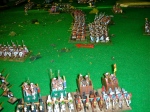Time to finish up several After Action reports (AAR) on recent New Year scenarios at the warren, David’s garage, and the Strategicon-OrcCon 2019 LAX convention. First AAR is an unusual Clash of Empires 28mm Mercenary War scenario, featuring defeated Carthage vs. their former hired mercenaries after the conclusion of the 1st Punic War. Before this afternoon of ancient tabletop warfare, WR must admit his knowledge of the post 1st Punic War Carthaginian wars was grossly lacking, in reality WR must state as nonexistent. So, welcome to the Battle of Bagradas River 240 B.C.
The Battle of the Bagradas River, or the Macar by another name (c. 240 BC), was fought by the loyal Carthaginian army (civic levy in most part) against former Carthaginian mercenaries awaiting payment for service after the peace of the 1st Punic War, and joined by rebelling Libyan cities. After the forces of Hanno the Great were defeated at Utica, and failed to engage the mercenaries afterwards despite favorable conditions, Carthage raised a new army under Hamilcar Barca in Carthage. Hamilcar managed to leave Carthage despite the lacking rebel blockade of the city and cross the Bagradas River (the ancient name of the Medjerda). Rebel armies from besieging Utica and the camp guarded the bridge on the Bagradas River. Hamilcar Barca, by brilliant maneuvering, defeated the combined rebel army. This was the first major Carthaginian victory of the war.
Sources for this period of Carthage are hard to come by, most could be viewed as secondary in their reporting. WR’s friend David Kometz used the following internet information for structure and background material for his COE tabletop Battle of Bargaras River scenario design. The Wikipedia article seems a good overview with some detail on this battle.
The Carthaginian army has surprised the rebels near their respective camps and marched on the tabletop fully deployed. They will set up 40cm from their long table edge with a deployment zone total width of eight feet, centered at the 16×6 table centerline. Thus they can deploy up to four feet from the table bisecting centerline, facing both enemy camps or either one individually. This is a important decision for the Carthage players to decide. The “Bridgehead” rebel Mercenary / Libyan levy camp starts near the stone bridge. All units start across the river, on the same side as the Carthaginian arriving army, placed along the river within 16″ of the bridge (either side), and cannot extend from river edge by 12″. The mercenary / Libyan units cannot cross the river via the bridge to avoid combat and are considered lost for scenario victory conditions if they cross. Units forced into the river are considered destroyed. The upriver “Riverbank” rebels start near their camp along the river near the short table edge. Like the “Bridgehead” camp, they must start within 16″ of the short table edge, measured from the table edge and river exit point. Scenario lasts eight turns with diced 50% chance for additional turns after the conclusion of turn eight. Carthage has first movement as the rebels seek to recover from their surprise reaction seeing the Carthaginians rearward approach. Victory based on total victory points calculation found in COE MRB pages 132-133.

The 16×6 foot table starting set up. Upper left deployed Carthaginian army. Upper right Mercenary /Libyan levy “Bridgehead” command. Foreground shows “Riverbank” mercenary /Libyans.
Terrain notes: A simple straight gravel road somewhat bisects the table near the center point and crosses the bridge. The stone bridge crosses the Bargaras River off-center to the table centerline by 6″ it seems viewing the post battle photos. A small riverside marsh or swampy ground is placed about 2 feet from the bridge, again view the photos for size and placement. Otherwise, the tabletop battlefield is open with scattered light bushes to break up the flatness. Note: The bridge procession is worth extra victory points if controlled by the Carthaginians or likewise, control the “Riverbank” force’s encampment tents as told to the mercenary rebellion player side. Extra victory points unknown to WR during game but I think it was 50 VP per site.














































